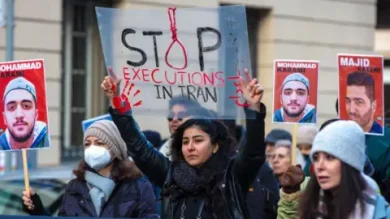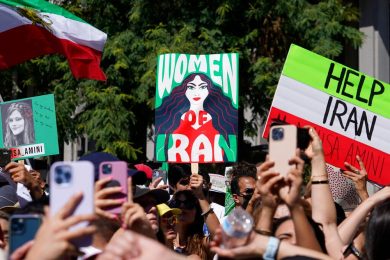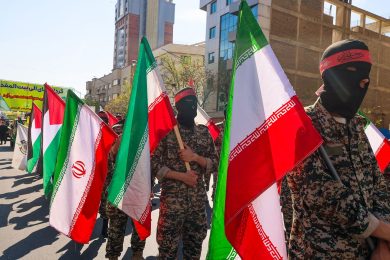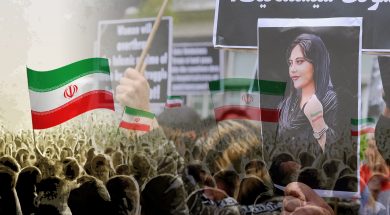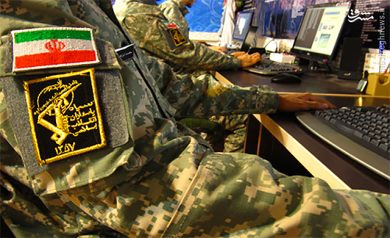Iranian women have long faced systematic repression under the Islamic Republic’s authoritarian regime, with the Islamic Revolutionary Guard Corps (IRGC) playing a central role in enforcing policies that suppress their rights. Through its Basij militia and morality police, the IRGC has acted as the regime’s enforcer, targeting women who defy restrictive laws and societal norms. Despite the risks, Iranian women have consistently stood on the frontline of resistance, fighting for freedom, equality, and justice.
This analysis explores the IRGC’s oppressive tactics against women, the resilience of those who defy them, and the broader implications of their fight for change.
The IRGC’s Role in Women’s Oppression
The IRGC is deeply embedded in Iran’s governance and society, tasked with preserving the principles of the 1979 Islamic Revolution. Among its mandates is the enforcement of strict interpretations of Islamic law, which disproportionately target women.
1. Enforcing the Mandatory Hijab
One of the most visible forms of the IRGC’s control is the enforcement of Iran’s mandatory hijab laws. Women deemed “improperly” veiled are harassed, fined, or arrested by the morality police, a force closely linked to the IRGC. Such policies not only limit women’s autonomy but also symbolize the regime’s broader control over personal freedoms.
2. Suppression of Protests
The IRGC has played a key role in violently suppressing women-led protests, such as those sparked by Mahsa Amini’s death in 2022. Demonstrations against mandatory hijab laws and gender discrimination are met with tear gas, arrests, and brutal crackdowns by IRGC forces.
3. Targeting Activists
Women’s rights activists are frequently detained and imprisoned by the IRGC for challenging discriminatory laws or advocating for reform. Many are subjected to psychological and physical torture in IRGC-controlled detention centers.
Stories of Resistance
Despite the IRGC’s attempts to silence dissent, Iranian women continue to resist, often at great personal risk. Their courage has inspired national and global movements.
1. Mahsa Amini: A Catalyst for Change
Mahsa Amini’s death in IRGC custody became a symbol of resistance against the regime’s oppression. Her story sparked nationwide protests, with women leading the charge by removing their hijabs, cutting their hair, and demanding systemic change.
2. The Girls of Revolution Street
In 2017, women in Tehran and other cities publicly removed their hijabs, waving them on sticks in defiance of Iran’s dress code laws. This act of bravery became a viral movement, highlighting the power of individual resistance against the IRGC’s control.
3. Nasrin Sotoudeh: Fighting for Justice
Nasrin Sotoudeh, a renowned human rights lawyer, has been imprisoned multiple times for defending women’s rights activists and opposing the IRGC’s oppressive policies. Her unwavering dedication exemplifies the resilience of women fighting for justice.
How Women Resist the IRGC
Women in Iran have developed diverse methods to defy the IRGC’s repression, combining grassroots activism with modern tools.
1. Public Acts of Defiance
From removing their hijabs to organizing sit-ins, women use public spaces to challenge the IRGC’s authority, often sparking broader movements.
2. Digital Activism
Social media has become a powerful tool for women to document abuses, share their stories, and mobilize support. Despite internet censorship and surveillance, platforms like Instagram and Twitter amplify their voices globally.
3. Building Solidarity
Women in Iran create networks of mutual support, sharing resources and strategies to resist the IRGC’s oppressive tactics. These grassroots efforts foster a sense of community and resilience.
The Broader Impact of Women’s Resistance
The courage of Iranian women has significant implications for the fight against the IRGC and the broader push for democracy and human rights in Iran.
1. Undermining the Regime’s Legitimacy
Women’s defiance challenges the regime’s narrative of control and highlights the hypocrisy of its claim to uphold justice and morality.
2. Inspiring Global Solidarity
Iranian women’s resistance has inspired protests and advocacy campaigns worldwide, drawing attention to the IRGC’s abuses and mobilizing international support for their cause.
3. Empowering Broader Movements
Women’s leadership in the fight against the IRGC has inspired other marginalized groups, including students, workers, and minorities, to join the push for systemic change.
The Cost of Resistance
The IRGC’s response to women’s resistance is often brutal. Those who defy the regime face severe consequences, including:
• Arrests and Imprisonment: Activists and protesters are frequently detained without due process.
• Torture and Intimidation: Many detainees report physical and psychological abuse in IRGC-controlled facilities.
• Harassment of Families: The IRGC often targets the families of activists to intimidate and silence them.
What Can Be Done
The international community has a vital role to play in supporting Iranian women and holding the IRGC accountable. Key actions include:
1. Sanctions and Accountability: Imposing targeted sanctions on IRGC leaders and entities responsible for human rights abuses.
2. Amplifying Voices: Providing platforms for Iranian women to share their stories and advocate for change.
3. Supporting Civil Society: Funding and empowering grassroots organizations that work to protect women’s rights and document abuses.
Conclusion
Iranian women’s fight against the IRGC’s oppression is a testament to their resilience and courage. Despite facing systemic repression, they continue to lead the charge for freedom and equality, inspiring movements within and beyond Iran’s borders. Confronting the IRGC’s abuses and amplifying the voices of these women is not just a moral imperative—it is essential for building a more just and equitable future.
Join Our Newsletter!
Stay informed with the latest updates, news, and ways to take action in the fight for justice and global security. Sign up now to get updates delivered straight to your inbox!

